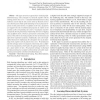1201 search results - page 135 / 241 » On the cardinality of fuzzy sets |
ISDA
2010
IEEE
14 years 7 months ago
2010
IEEE
A genetic algorithm is combined with two variants of the modularity (Q) network analysis metric to examine a substantial amount fisheries catch data. The data set produces one of t...
104
click to vote
TNN
2010
14 years 4 months ago
2010
Soft computing (SC) emerged as an integrating framework for a number of techniques that could complement one another quite well (artificial neural networks, fuzzy systems, evolutio...
IAT
2005
IEEE
15 years 3 months ago
2005
IEEE
Trust management model that we present is adapted for ubiquitous devices cooperation, rather than for classic client-supplier relationship. We use fuzzy numbers to represent trust...
EUSFLAT
2009
14 years 7 months ago
2009
Abstract-- This paper presents an approach for visualizing highdimensional fuzzy rules arranged in a hierarchy together with the training patterns they cover. A standard multi-dime...
159
click to vote
ICLP
2009
Springer
15 years 10 months ago
2009
Springer
Abstract. We present the first comprehensive approach to integrating cardinality and weight rules into conflict-driven ASP solving. We begin with a uniform, constraint-based charac...

